Avoid infecting your system with malware via fake "American Express" emails
Phishing/ScamAlso Known As: American Express spam
Get free scan and check if your device is infected.
Remove it nowTo use full-featured product, you have to purchase a license for Combo Cleaner. Seven days free trial available. Combo Cleaner is owned and operated by RCS LT, the parent company of PCRisk.com.
What is "American Express" email virus?
"American Express Email Virus" is one of many spam campaigns used by scammers to proliferate computer infections. Scammers use this (and other similar) email scams to trick people into opening presented attachments (HTML files). Opening this particular attachment will result in users having various personal details stolen.
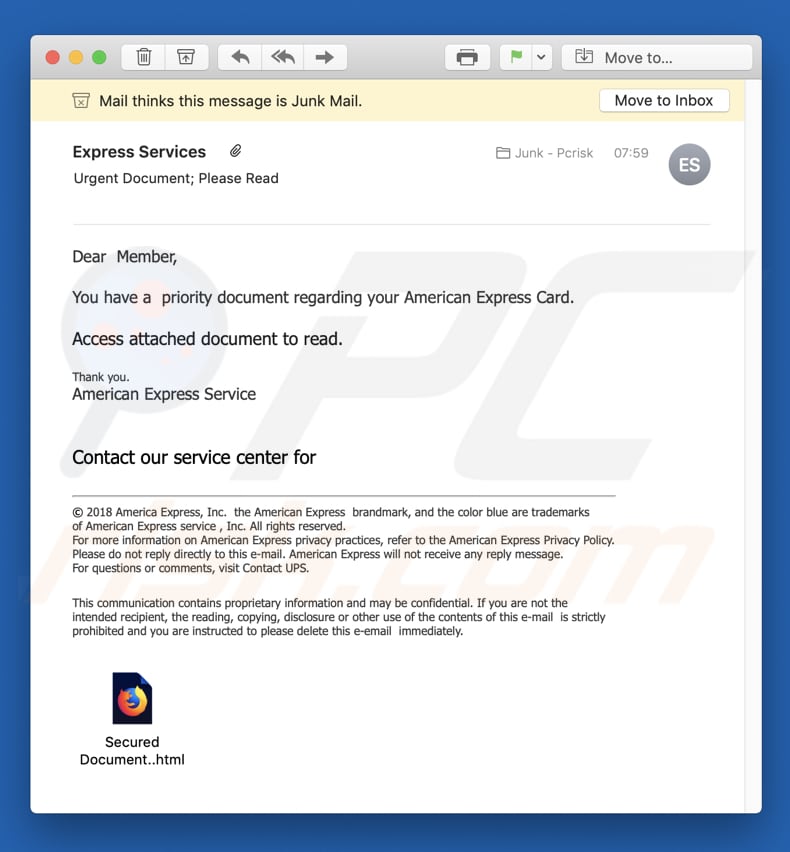
"American Express" email virus overview
Scammers present the "American Express Email Virus" scam as an important/urgent email relating to an American Express card. Note that American Express (a financial services company) has nothing to do with this scam. Scammers who send these emails often claim to be representatives of well-known companies.
Generally, attachments presented in these scams are used to infect computers and steal personal data. In this case, the main purpose is to trick recipients into opening the presented HTML file, which then opens a deceptive website on which users are asked to provide their banking details (see screenshot below).
This scam is probably used to proliferate malicious software such as Emotet. In any case, providing the required details (or, in other cases, simply opening the attachments) usually results in various privacy issues, financial loss, browsing safety problems, and so on. We recommend that you ignore these emails and that you do not download or open the attachments or web links.
| Name | American Express spam |
| Threat Type | Trojan, Password stealing virus, Banking malware, Spyware |
| Symptoms | Trojans are designed to stealthily infiltrate victim's computer and remain silent thus no particular symptoms are clearly visible on an infected machine. |
| Distribution methods | Infected email attachments, malicious online advertisements, social engineering, software cracks. |
| Damage | Stolen banking information, passwords, identity theft, victim's computer added to a botnet. |
| Malware Removal (Windows) |
To eliminate possible malware infections, scan your computer with legitimate antivirus software. Our security researchers recommend using Combo Cleaner. Download Combo CleanerTo use full-featured product, you have to purchase a license for Combo Cleaner. 7 days free trial available. Combo Cleaner is owned and operated by RCS LT, the parent company of PCRisk.com. |
Malspam in general
Typically, these spam campaigns are used to proliferate viruses. Some examples of possible infections are Adwind, FormBook, TrickBot, LokiBot, and so on. Generally, these are presented in emails are used to steal personal details (logins, passwords, etc.) or cause other infections (chain infections). Therefore, eliminate malicious software immediately.
How do spam campaigns infect computers?
This particular spam campaign is used to trick people into opening the provided HTML file, which leads to a deceptive website. On this site, users are asked to provide banking account details such as usernames, passwords, and digits from their American Express cards. In other cases, scammers attach Microsoft Office documents, PDF archives, executables, or other files. These must be opened, extracted, and then executed manually for the infections to proliferate.
How to avoid installation of malware?
Do not download or open (execute) files that are attached to emails received from suspicious, untrustworthy or unknown addresses. These deceptive emails can often be identified, since they do not relate to their recipients or are irrelevant. Have a trustworthy (reputable) anti-virus or anti-spyware suite installed and keep it enabled.
These tools can prevent computer infection by viruses and stop them before they can proliferate/cause further infections. If you have already opened malicious attachments, run a scan with Combo Cleaner Antivirus for Windows to automatically eliminate infiltrated malware.
Text presented in the "American Express Email Virus" email message:
Subject: Urgent Document; Please Read
Dear Member,
You have a priority document regarding your American Express Card.
Access attached document to read.Thank you.
American Express Service
Contact our service center for
© 2018 America Express, Inc. the American Express brandmark, and the color blue are trademarks of American Express service , Inc. All rights reserved.
For more information on American Express privacy practices, refer to the American Express Privacy Policy.
Please do not reply directly to this e-mail. American Express will not receive any reply message.
For questions or comments, visit Contact UPS.This communication contains proprietary information and may be confidential. If you are not the intended recipient, the reading, copying, disclosure or other use of the contents of this e-mail is strictly prohibited and you are instructed to please delete this e-email immediately.
Screenshot of a deceptive website designed to steal banking details:
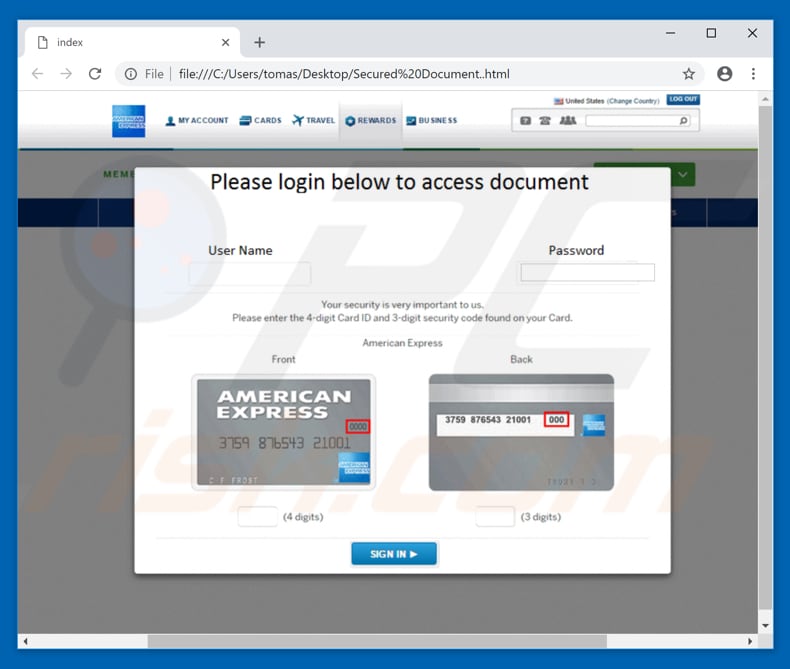
Another variant of "American Express Email Virus" spam campaign. This time crooks add an html file which downloads a script, rather than asking to enter account credentials. The downloaded script is designed to look like American Express bank's website and ask users to enter a bunch of different details which are automatically saved in a remote server controlled by cyber criminals.
Screenshot of the email letter:
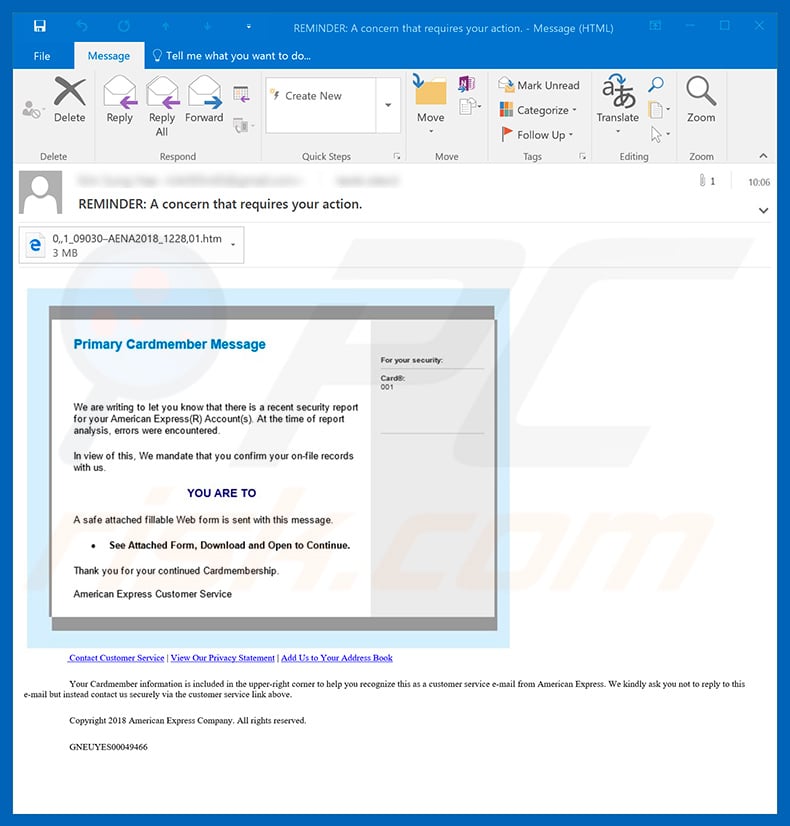
Text presented within this email:
Subject: REMINDER: A concern that requires your action.
Primary Cardmember MessageFor your security:
________________________________________We are writing to let you know that there is a recent security report for your American Express(R) Account(s). At the time of report analysis, errors were encountered.
In view of this, We mandate that you confirm your on-file records with us.
YOU ARE TO
A safe attached fillable Web form is sent with this message.
• See Attached Form, Download and Open to Continue.
Thank you for your continued Cardmembership.American Express Customer Service Card®:
001________________________________________
Contact Customer Service | View Our Privacy Statement | Add Us to Your Address Book
Your Cardmember information is included in the upper-right corner to help you recognize this as a customer service e-mail from American Express. We kindly ask you not to reply to this e-mail but instead contact us securely via the customer service link above.
Copyright 2018 American Express Company. All rights reserved.
GNEUYES00049466
Screenshot of the website delivered by downloaded script:
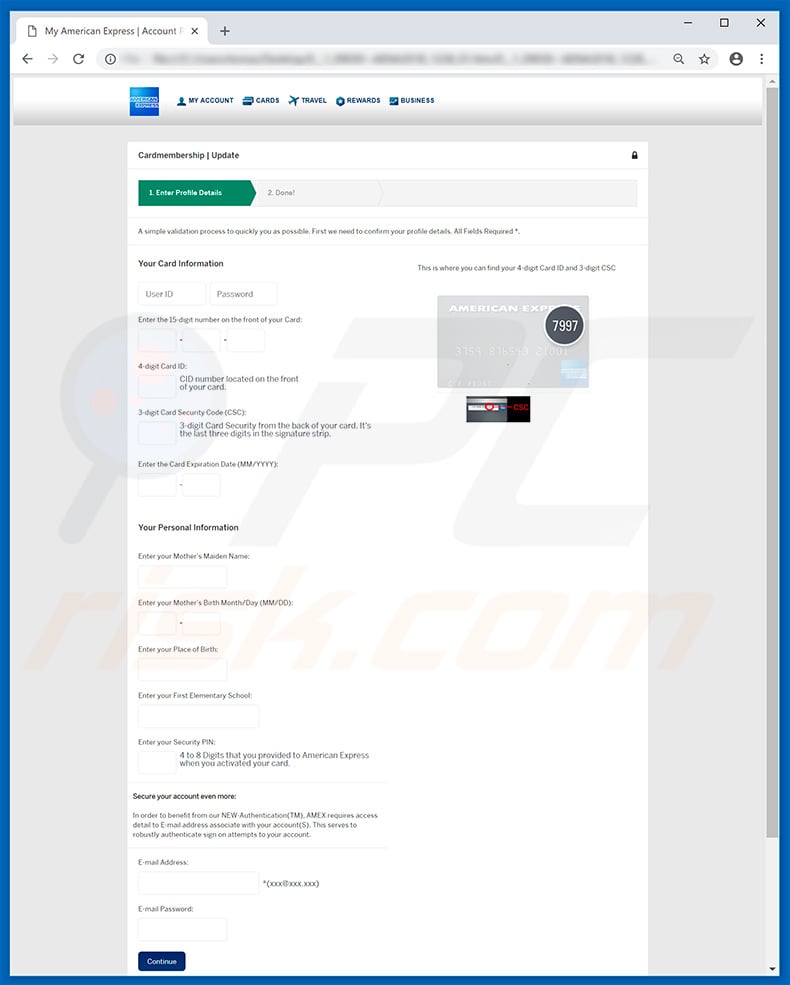
Another example of American Express-themed spam email which promotes a phishing website:
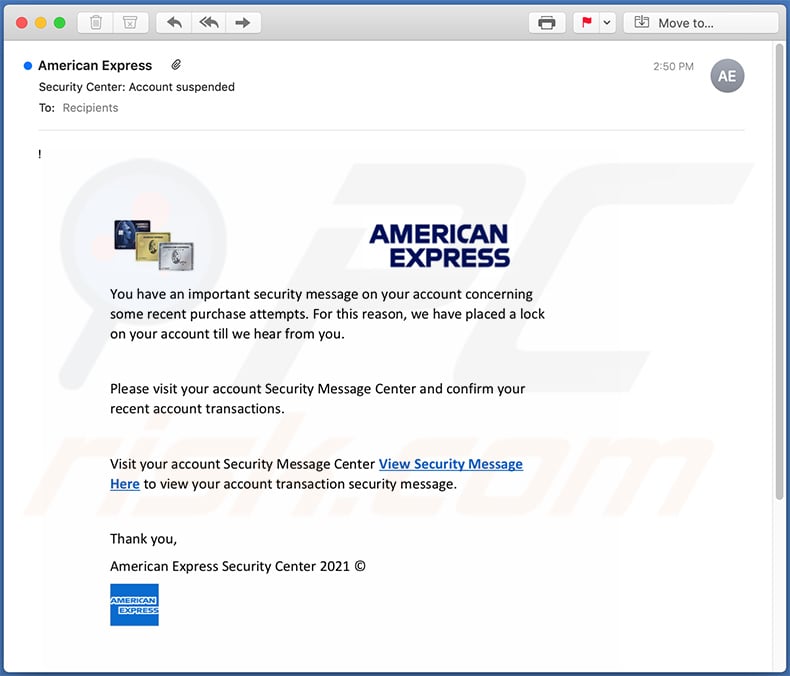
Text presented within:
Subject: Security Center: Account suspended
You have an important security message on your account concerning some recent purchase attempts. For this reason, we have placed a lock on your account till we hear from you.
Please visit your account Security Message Center and confirm your recent account transactions.
Visit your account Security Message Center View Security Message Here to view your account transaction security message.
Thank you,
American Express Security Center 2021 ©
Screenshot of the promoted phishing site:
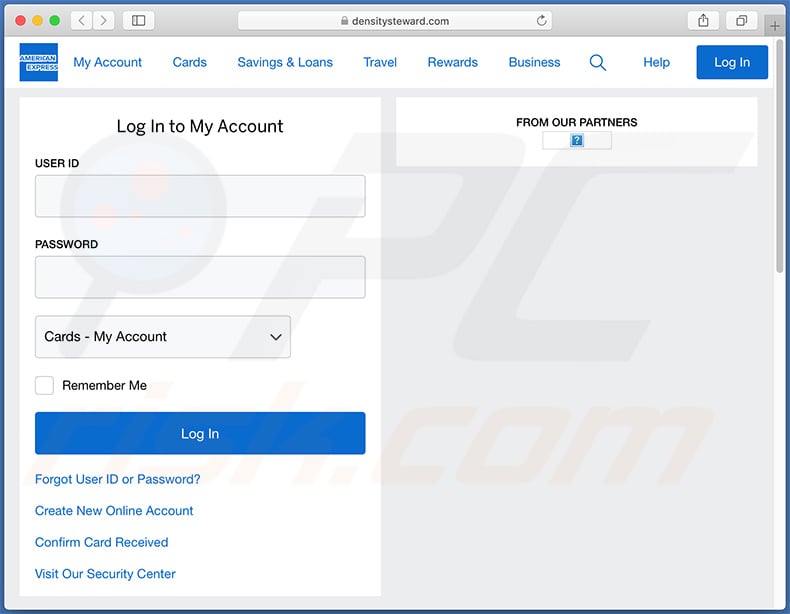
Another example of American Express-themed spam email promoting a phishing website:
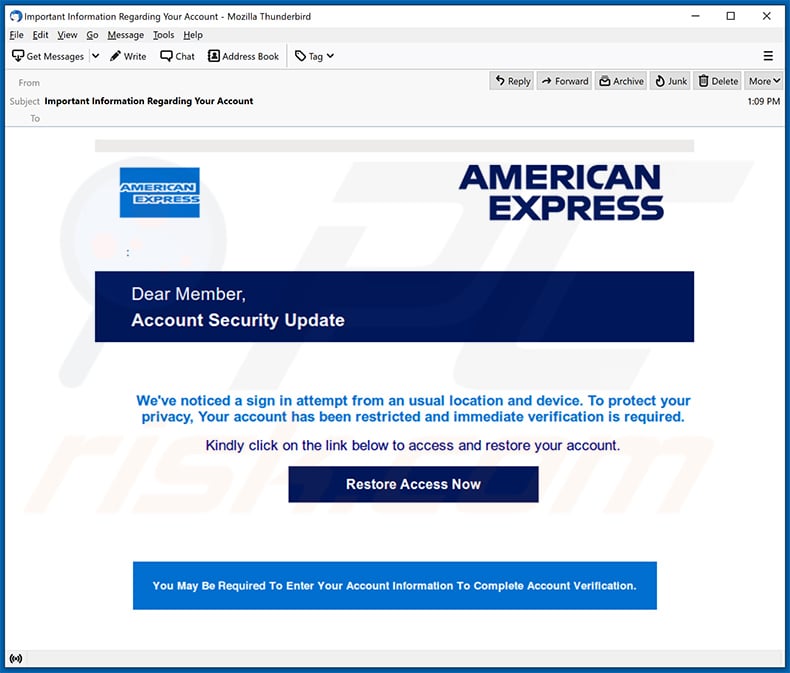
Text presented within:
AMERICAN EXPRESS
Dear Member,
Account Security UpdateWe've noticed a sign in attempt from an unusual location and device. To protect your privacy, Your account has been restricted and immediate verification is required.
Kindly click on the link below to access and restore your account.
Restore Access Now
You May Be Required To Enter Your Account Information To Complete Account Verification.
Screenshot of the promoted phishing website:
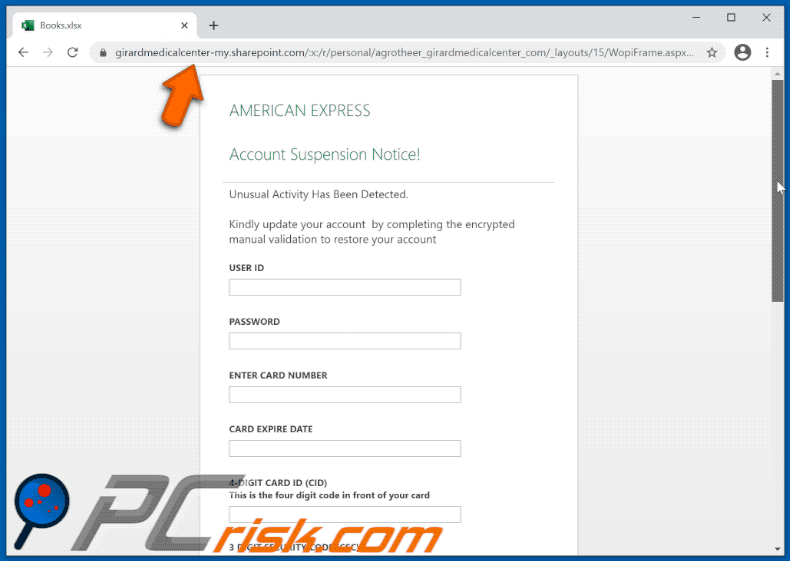
Text presented within:
AMERICAN EXPRESS
Account Suspension Notice!
Unusual Activity Has Been Detected.Kindly update your account by completing the encrypted manual validation to restore your account
Yet another variant of American Express-themed spam email used to promote a phishing website:
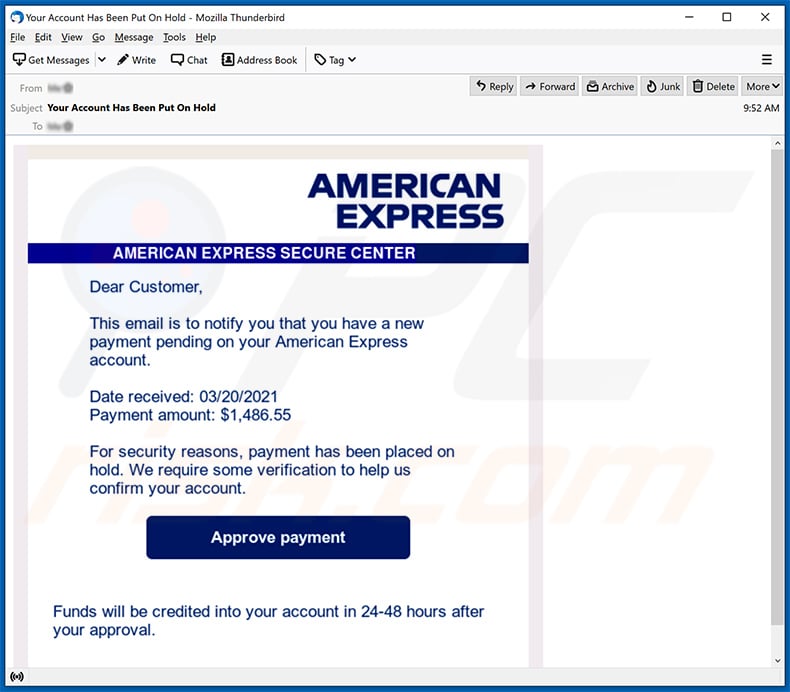
Text presented within:
Subject: Your Account Has Been Put On Hold
AMERICAN EXPRESS
AMERICAN EXPRESS SECURE CENTER
Dear Customer,
This email is no notify you that you have a new payment pending on your American Express account.
Date received: 03/20/2021
Payment amount: $1,486.55For security reasons, payment has been placed on hold. We require some verification to help us confirm your account.
Approve payment
Funds will be credited into your account in 24/48 hours after your approval.
Another example of American Express-themed spam email distributing a HTML file designed for phishing purposes:
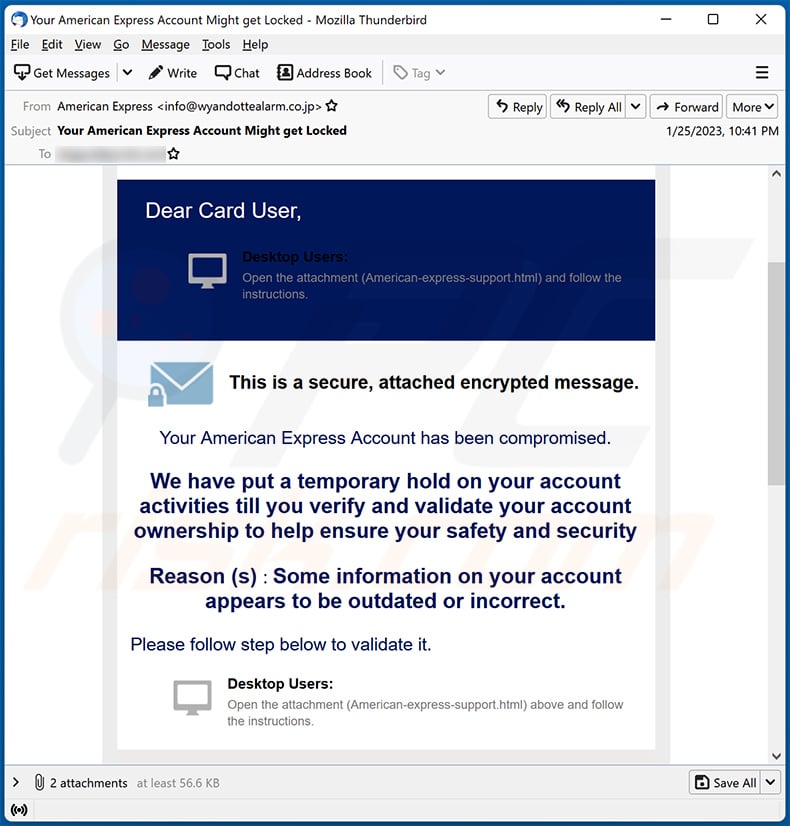
Text presented within:
Subject: Your American Express Account Might get Locked
New Payment Received on Dec 16, 2020
ACCOUNT ENDING: -XXXXX
Dear Card User,
Desktop Users:Open the attachment (American-express-support.html) and follow the instructions.
This is a secure, attached encrypted message.
Your American Express Account has been compromised.
We have put a temporary hold on your account activities till you verify and validate your account ownership to help ensure your safety and security
Reason (s) : Some information on your account appears to be outdated or incorrect.
Please follow step below to validate it.
Desktop Users:
Open the attachment (American-express-support.html) above and follow the instructions.
Screenshot of the attached HTML file:
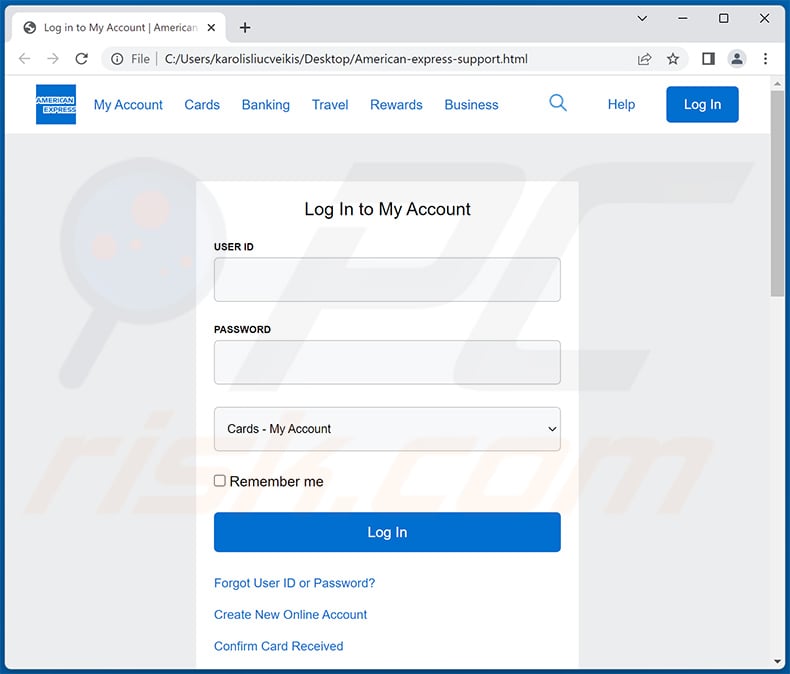
Instant automatic malware removal:
Manual threat removal might be a lengthy and complicated process that requires advanced IT skills. Combo Cleaner is a professional automatic malware removal tool that is recommended to get rid of malware. Download it by clicking the button below:
DOWNLOAD Combo CleanerBy downloading any software listed on this website you agree to our Privacy Policy and Terms of Use. To use full-featured product, you have to purchase a license for Combo Cleaner. 7 days free trial available. Combo Cleaner is owned and operated by RCS LT, the parent company of PCRisk.com.
Quick menu:
- What is American Express spam?
- Types of malicious emails.
- How to spot a malicious email?
- What to do if you fell for an email scam?
Types of malicious emails:
![]() Phishing Emails
Phishing Emails
Most commonly, cybercriminals use deceptive emails to trick Internet users into giving away their sensitive private information, for example, login information for various online services, email accounts, or online banking information.
Such attacks are called phishing. In a phishing attack, cybercriminals usually send an email message with some popular service logo (for example, Microsoft, DHL, Amazon, Netflix), create urgency (wrong shipping address, expired password, etc.), and place a link which they hope their potential victims will click on.
After clicking the link presented in such email message, victims are redirected to a fake website that looks identical or extremely similar to the original one. Victims are then asked to enter their password, credit card details, or some other information that gets stolen by cybercriminals.
![]() Emails with Malicious Attachments
Emails with Malicious Attachments
Another popular attack vector is email spam with malicious attachments that infect users' computers with malware. Malicious attachments usually carry trojans that are capable of stealing passwords, banking information, and other sensitive information.
In such attacks, cybercriminals' main goal is to trick their potential victims into opening an infected email attachment. To achieve this goal, email messages usually talk about recently received invoices, faxes, or voice messages.
If a potential victim falls for the lure and opens the attachment, their computers get infected, and cybercriminals can collect a lot of sensitive information.
While it's a more complicated method to steal personal information (spam filters and antivirus programs usually detect such attempts), if successful, cybercriminals can get a much wider array of data and can collect information for a long period of time.
![]() Sextortion Emails
Sextortion Emails
This is a type of phishing. In this case, users receive an email claiming that a cybercriminal could access the webcam of the potential victim and has a video recording of one's masturbation.
To get rid of the video, victims are asked to pay a ransom (usually using Bitcoin or another cryptocurrency). Nevertheless, all of these claims are false - users who receive such emails should ignore and delete them.
How to spot a malicious email?
While cyber criminals try to make their lure emails look trustworthy, here are some things that you should look for when trying to spot a phishing email:
- Check the sender's ("from") email address: Hover your mouse over the "from" address and check if it's legitimate. For example, if you received an email from Microsoft, be sure to check if the email address is @microsoft.com and not something suspicious like @m1crosoft.com, @microsfot.com, @account-security-noreply.com, etc.
- Check for generic greetings: If the greeting in the email is "Dear user", "Dear @youremail.com", "Dear valued customer", this should raise suspiciousness. Most commonly, companies call you by your name. Lack of this information could signal a phishing attempt.
- Check the links in the email: Hover your mouse over the link presented in the email, if the link that appears seems suspicious, don't click it. For example, if you received an email from Microsoft and the link in the email shows that it will go to firebasestorage.googleapis.com/v0... you shouldn't trust it. It's best not to click any links in the emails but to visit the company website that sent you the email in the first place.
- Don't blindly trust email attachments: Most commonly, legitimate companies will ask you to log in to their website and to view any documents there; if you received an email with an attachment, it's a good idea to scan it with an antivirus application. Infected email attachments are a common attack vector used by cybercriminals.
To minimise the risk of opening phishing and malicious emails we recommend using Combo Cleaner Antivirus for Windows.
Example of a spam email:

What to do if you fell for an email scam?
- If you clicked on a link in a phishing email and entered your password - be sure to change your password as soon as possible. Usually, cybercriminals collect stolen credentials and then sell them to other groups that use them for malicious purposes. If you change your password in a timely manner, there's a chance that criminals won't have enough time to do any damage.
- If you entered your credit card information - contact your bank as soon as possible and explain the situation. There's a good chance that you will need to cancel your compromised credit card and get a new one.
- If you see any signs of identity theft - you should immediately contact the Federal Trade Commission. This institution will collect information about your situation and create a personal recovery plan.
- If you opened a malicious attachment - your computer is probably infected, you should scan it with a reputable antivirus application. For this purpose, we recommend using Combo Cleaner Antivirus for Windows.
- Help other Internet users - report phishing emails to Anti-Phishing Working Group, FBI’s Internet Crime Complaint Center, National Fraud Information Center and U.S. Department of Justice.
Frequently Asked Questions (FAQ)
Why did I receive this email?
Spam emails are not personal. These letters are distributed in massive campaigns, and thousands of users receive identical ones.
I have provided my personal information when tricked by this spam email, what should I do?
If you have provided account credentials – immediately change the passwords of all possibly exposed accounts and inform their official support. And if you've disclosed other private information (e.g., ID card details, credit card numbers, etc.) – contact the corresponding authorities without delay.
I have read a spam email but didn't open the attachment, is my computer infected?
Merely reading an email will not initiate any system infection processes. Devices are infected when malicious attachments or links present in spam mail are opened.
I have downloaded and opened a file attached to a spam email, is my computer infected?
Whether the device was infected might depend on the opened file's format. If it was an executable (.exe, .run, etc.) – most likely, yes – the system was infected. However, document formats (.doc, .xls, .pdf, etc.) may require additional user interaction (e.g., enabling macro commands) to begin downloading/installing malware.
Will Combo Cleaner remove malware infections present in email attachments?
Yes, Combo Cleaner is capable of detecting and eliminating most of the known malware infections. It must be stressed that running a complete system scan is crucial – since sophisticated malicious programs usually hide deep within systems.
Share:

Tomas Meskauskas
Expert security researcher, professional malware analyst
I am passionate about computer security and technology. I have an experience of over 10 years working in various companies related to computer technical issue solving and Internet security. I have been working as an author and editor for pcrisk.com since 2010. Follow me on Twitter and LinkedIn to stay informed about the latest online security threats.
PCrisk security portal is brought by a company RCS LT.
Joined forces of security researchers help educate computer users about the latest online security threats. More information about the company RCS LT.
Our malware removal guides are free. However, if you want to support us you can send us a donation.
DonatePCrisk security portal is brought by a company RCS LT.
Joined forces of security researchers help educate computer users about the latest online security threats. More information about the company RCS LT.
Our malware removal guides are free. However, if you want to support us you can send us a donation.
Donate
▼ Show Discussion